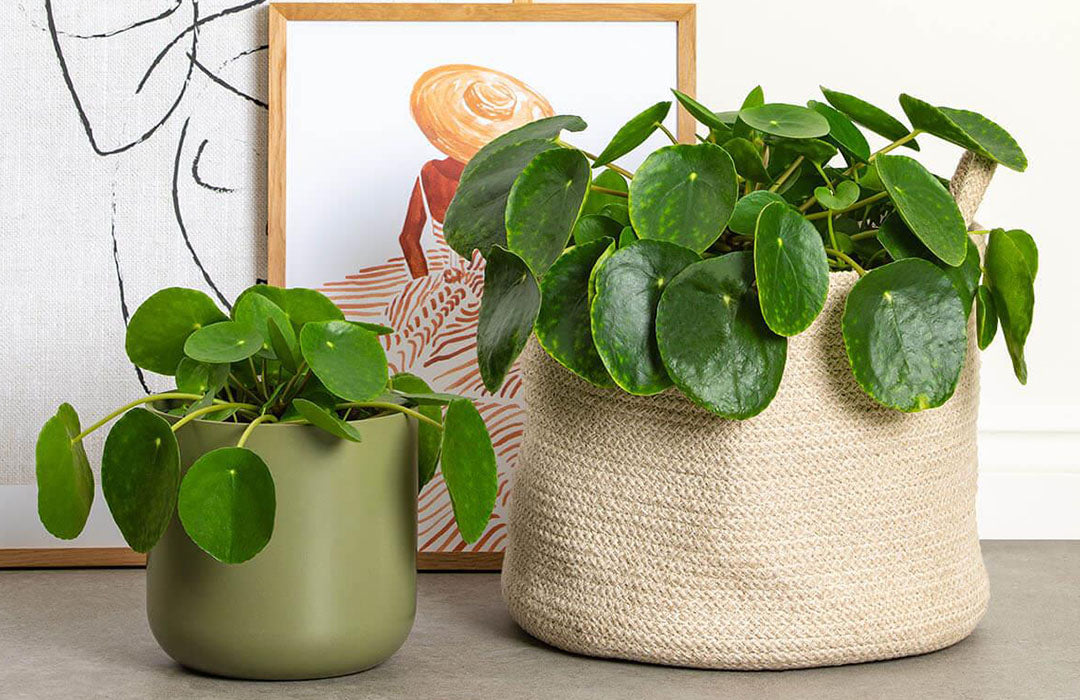When it comes to indoor plants, the Pilea Peperomioides - commonly known as the Chinese Money Plants, take some beating. It just ticks all the boxes most people are looking for: it's pretty low maintenance, it helps purify the air, it's supposed to be very lucky (an added bonus), and most importantly of all - it is a gorgeous plant.

We want to focus on the first element today - because while they are low maintenance you need to know a few things to make sure your Chinese Money Plant stays healthy for a very long time. A little bit of effort goes a very long way with this stylish little plant - and we will detail below everything you need to know about how to care for a Chinese Money Plant.
Are Chinese Money Plants easy to care for?
Yes - these are perfect for a novice plant owner. It's one of the many reasons they make a great gift for someone, particularly if they are moving house, or to wish them good luck (these plants are thought to bring luck to everyone who owns it - and who doesn't need a bit more luck..?!)
So if you are worried at this stage whether you can cope with caring for a Chinese Money Plant, then the short answer is yes. A lot of what we are about to discuss is common sense, and if you've bothered to click on a 'Chinese Money Plant Care' blog then you already have passed the common sense test!
What are Chinese Money Plants?
Hailing from southern China, the Pilea Peperomioides is known by a few different names. The most common is the 'Chinese Money Plant' - which is linked to the fact that these plants were said to bring the owner good luck and money.
But there are a host of other names attributed to this popular little plant: Pancake Plant - due to the big flat leaves, which also accounts for the name UFO Plant, and it's been known as the Friendship Plant and the Pass-It-On Plant as it is seen as a great plant to gift to people. It was called the Missionary Plant after a Swedish missionary brought one to Europe from China in 1946, and it's also been known as the Pilea Plant and the Lefse Plant.
How to care for the Chinese Money Plant
As we alluded to, caring for a Chinese Money Plant largely comes down to common sense. It can survive a little neglect (you don't need to worry about getting someone to take care of it while you are on holiday, for example), but if you follow our advice, you can keep it looking its best. Those beautiful leaves deserve a bit of effort!

They can tolerate some direct sunlight, but in the summer months you want to make sure it isn't exposed to too much. Bright, indirect light is best, next to a bright big window. If you notice the leaves getting a bit floppy, it may indicate that it is not getting enough light.
In terms of a watering schedule, you don't need to be too regimented - basically if the soil feels dry, give it a drink, and if it is moist, leave it for another few days. Like we said, it's just common sense really. If you find yellowing leaves, it could mean that it is getting too much water, or even that it has root rot - the best thing to do is to carefully remove the yellow leaves and let the soil dry out for a little while.
So, in summary:
-
Origins: Southern China
-
Light requirements: Bright indirect sunlight
-
Water requirements: When the top soil feels dry - roughly once a week. Likes mist on the leaves occasionally
-
Humidity requirements: Yes, these guys love humidity!
-
Soil requirements: Well-draining potting soil
-
Temperature requirements: 13°C to 30°C, minimum 12°C
-
Pruning requirements: Remove yellow, brown or dead leaves casually
Propagating Chinese Money Plants
Another huge benefit of owning a Chinese Money Plant is how easy it is to propagate. It creates baby plants often, and you can use these to grow a new plant. All you need to do is remove the baby plant from the mother plant with a fork, and place it in a few centimetres of water. Within a few weeks, you'll see that it will produce small roots, and then you can plant it.
Where should you put Chinese Money Plants?
These plants love bright light - so pop them in a lovely decorative pot (you can use a plastic pot, but we think these guys deserve the very best indoor pots), and put them by a nice, big window. Not too much direct sunlight, but in a nice bright spot.

Can you put a Chinese Money Plant in the bathroom?
Yeah, these plants are great for a bathroom - they thrive in moderately humid conditions. Just make sure it is still in a nice and bright spot. There are many other houseplants that thrive in these conditions, so you can create your very own indoor jungle!
Expand your indoor plant game with Prickle
Indoor plants are what we are all about, so if you want to add, or start, your collection, then we have the perfect plants for you. Check out one of our favourites, the Lil' Chinese Money Plant, or browse the rest of our extensive range for more inspiration.
And if you have any questions, hit us up on social media: @prickplantsuk or drop us an email; contact@prickleplants.co.uk - our dedicated team would love to help you.

